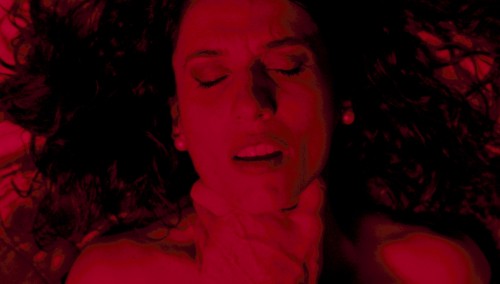Night Sight 2010
“The daily and imaginative handling of blood, other body fluids and occasionally naked beauty has always had more of an inspiring effect on directors than the heavy weight of serious issues.”
Dominik Graf; Sleeping Songs
The cold, freezing light of the small tube TV on a rickety plywood table brightens the basement room. The covers are on my nose: I can always pull it over my eyes to prevent the monsters and murderers from creeping into my head. I feel safe and afraid at the same time; I remember my youth as being contradictory. This is the space in which my passion arose for “that gruesome stuff”, as my mother has always called it, even up to this day, shaking her head. I am a child of the eighties, a child from the video store generation: every weekend I would get four movies and carry them home cerimoniously. The texture of the cover, the sound of the cassette as I slid it into the machine made my hands sweat in anticipation of the pleasure of fear. Again and again I would rewind the tape to start the horror all over again, still feeling safe. What I must refer to in my writing today as “genre film”, for the sake of general intelligibility, is my oldest friend: a fellow and companion, to which I will return again and again.
Genre means type, also means in cinema a set of designs and narrative means to arouse the desired emotions in the audience: a prison, say some. A prison in which everything is possible, say others. They are right, and evidence of this can be found in abundance in this year’s Night Sight program. A mad dance, composed of passions – for film, for life. There is room for at least one more book on the reception of Jean-Pierre Melville in the Far East: the French exceptional director’s crooks and his visually stunning presentation sparked the imagination of John Woo, for instance, who continued with The Killer (1989) those East-West cultural transfers that Melville had started in 1967 with Le Samouraï. From today’s perspective, both films complement one another. Although in terms of production history they were created completely independently from one another, it is as though they were made for each other: the ease with which the enigmatic central figure of the samurai/killer leaves decades (it is 22 years!) and continents behind, without deteriorating on the screen in the slightest, demonstrates the power of genre cinema. In 2009 Hong Kong director Johnnie To made Vengeance (Night Sight 2010 opening film) as an obvious homage to Melville, the samurai and the killer: instead of Alain Delon, who was originally chosen for the lead role, it is France’s noble rocker Johnny Hallyday, aged with impeccable dignity, who stands in the shower of bullets with a stony expression and piercing eyes. As an ex-hitman, now award-winning chef, he goes on a campaign of revenge. To stages him in opera-like action choreography, creating an existentially girded gangster film, which is past, present and the future all at once. They all return to the basement of their childhood, to the warm bosom of genre cinema: Amer is the title Bruno Forzani and Hélène Cattet gave their feature film debut, an ode, glowing in all the colors of lust, to giallo. The reference is to hard thrillers, derived from the popular pulp novels with a yellow cover (“giallo” is Italian for “yellow”), which had a decisive influence on the Italian production landscape in the sixties and seventies. The first was made by Mario Bava in 1963 and was called La ragazza che sapeva troppo, literally translated: The Girl Who Knew Too Much. A girl like this also haunts Forzani and Cattet’s masterfully constructed trauma landscapes in Amer, becoming a woman, pursued by a killer with black leather gloves. An urge for desire, a pleasure in fear. With [REC]2 the Catalans Jaume Balaguero and Paco Plaza return to their haunted house; Werner Herzog’s anxiety drama My Son, my Son, what have ye done? drags the horror genre through the swamp of his personal obsessions, and the surprise film restores a genre joked to death with blood & guts, eventually reaches for transcedence.
Night Sight 2010 demonstrates the strength of these alleged prisons: crooks, haunted houses, Vikings and scalpel murderers, ghosts of the past, radically present. In genre cinema, all the stories of the world are told, more tremendously, wildly and intelligently than most art bombers could do it. I feel a deep bond with these filmmakers: because just like me, they were once in a room (or elsewhere) huddled under the covers (or hiding somewhere else) and sensing the full power of cinema.
“I want to sing murder, for I love murderers. To sing it plainly. Without pretending, for example, that I want to be redeemed through it, though I do yearn for redemption, I would like to kill.”
Jean Genet (poet & prisoner) in “Our Lady of the Flowers”




